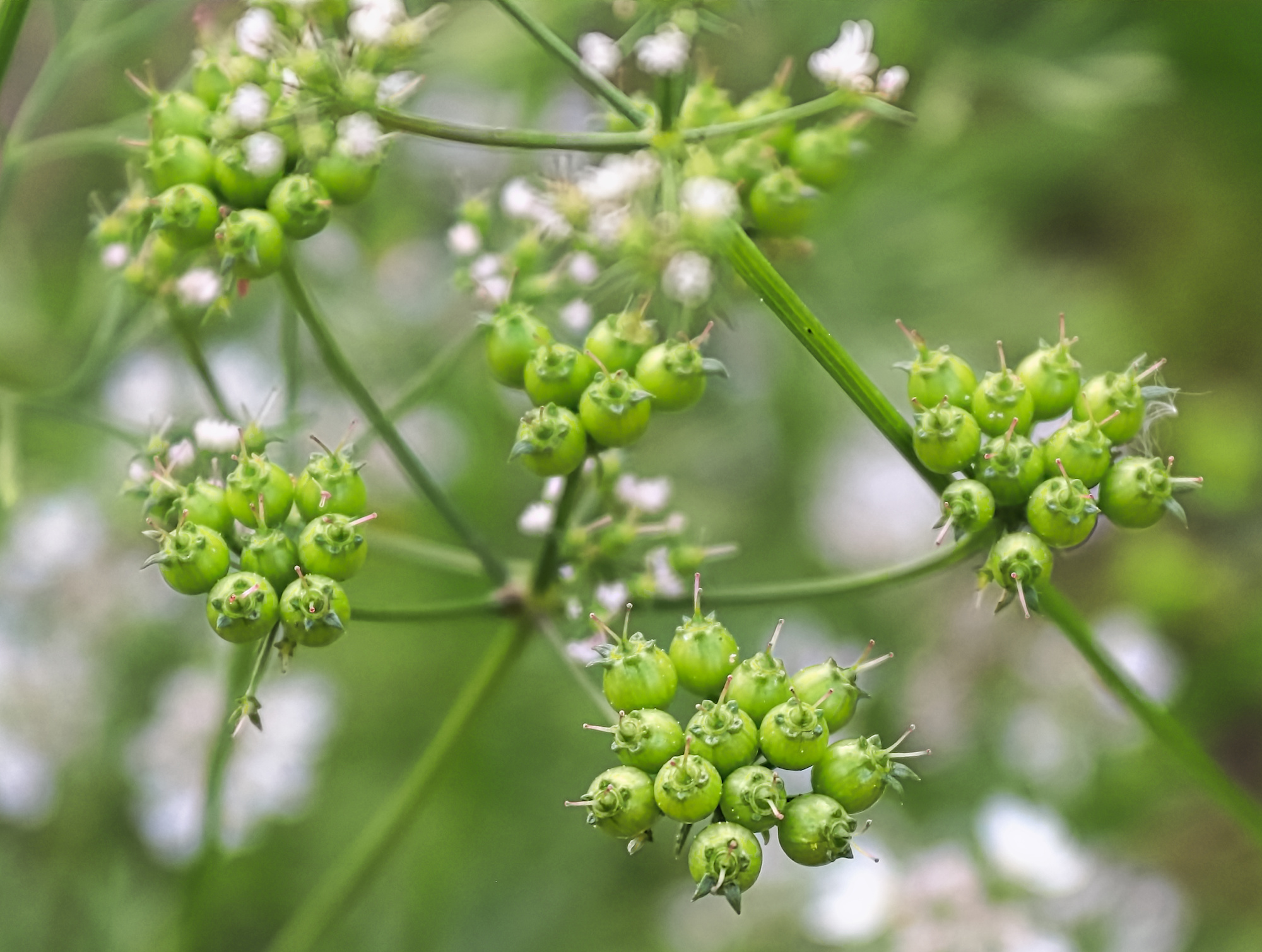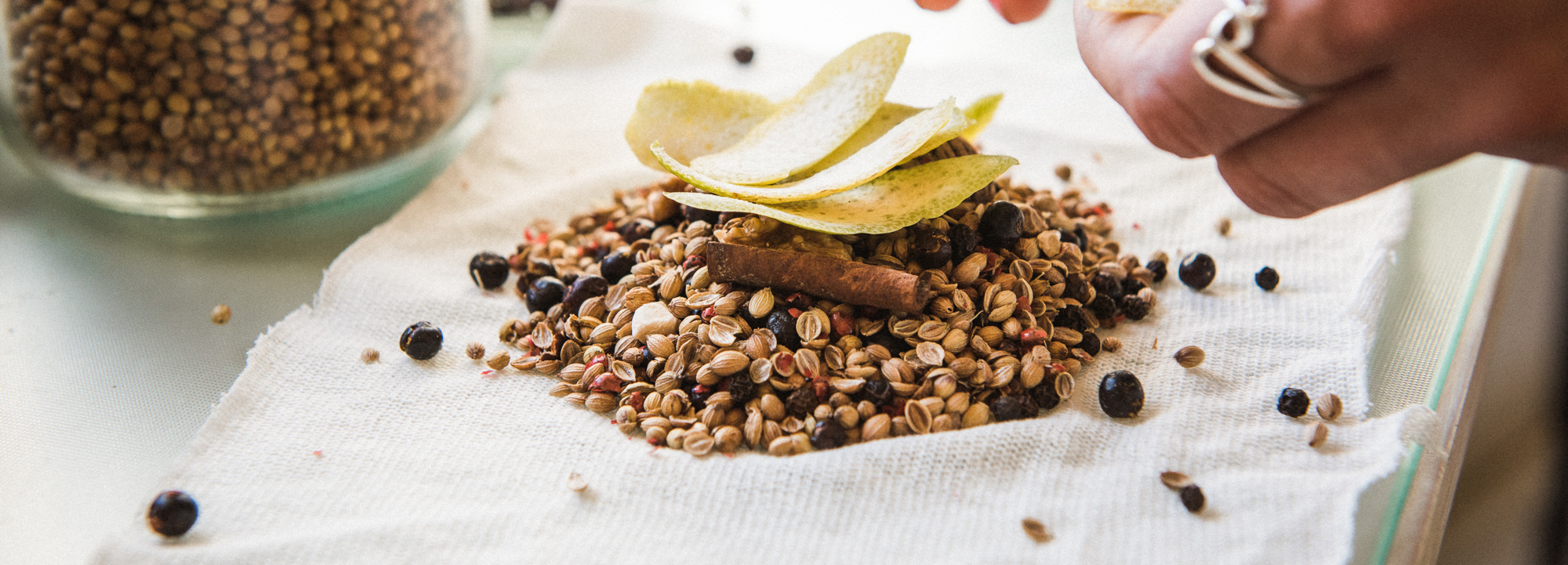Coriandrum sativum
ENCYCLOPEDIA BOTANICA / CORIANDER
A polarising herb with dedicated hate-groups on social media—as aldehydes in the fresh leaves produce a soapy, metallic, stink bug aroma that some find overwhelming. At the Lab we work with the dried seeds, which have a higher proportion of linalool than the leaves, and a wholly different aroma profile.
Description & Habitat
Coriander (sometimes called cilantro or Chinese parsley) is a leafy-green annual herb in the Apiaceae family that bears small fragrant seeds. Indigenous to Southern Europe, North Africa and Southeast Asia, it’s been cultivated for over 3000 years, and has a long history of use in cuisine and herbalism.
The plant is bright green, shiny and intensely aromatic. It blooms in the umbelliferous (umbrella-like) form typical to the carrot family—flowers are tiny and emerge in large flat clusters in pale mauve and white, delicate and pretty as the plant itself. Seed-clusters are green and symmetrical and fall to the ground when they ripen.
The plant is a delight to grow, and while it has a reputation for bolting it’s resilient in other ways—after distilling coriander seeds for essential oil and discarding the spent marc in the garden, we were amazed when a few months later we had crop of coriander on the way. Even after all that intense heat they remained viable. The resilience of plants!
All parts of the coriander plant including the root are edible, but the dried seeds are our focus in aromatic distilling.
Parts used: Seeds
Genetics mean some are particularly sensitive to aldehydes in coriander leaves

Umbels of green coriander seeds
Aroma & Flavour Profile
While the leaf can be soapy and divisive, the delightfully fragrant dried seeds are a totally different aromatic story. Unripe green seeds still share much of the leaf’s distinctive aldehydes, but as the seeds dry they undergo a chemical change as different compounds come to the fore—linalool, thymol and geranyl acetate. The presence of these compounds mean dried coriander seeds emit lovely woodsy notes of thyme and a rich perfume reminiscent of geranium with vibrant herby-citrus top notes.
Crush the seeds and you’re first greeted with the floral-citrus aromas of orange and lemon. These top notes are from linalool, a naturally occurring aroma compound found in many spices and flowers, as well as in orange peel. And at higher concentrations linalool produces woody and piney tones.
Interestingly, coriander seeds share a similar molecular composition to juniper berries, which could be part of why the pair blend together so harmoniously and why they appear in most classic gin blends.
When distilled, coriander seeds have a complex flavour—citrusy, nutty and spiced all at once—though the exact aroma profile of your coriander can vary a lot between variety and depending on where it’s sourced. We encourage you to experiment with different types and see which you prefer for your particular your purpose.
In the Lab we’ve been using New Zealand-grown coriander as opposed to the Indian-sourced varieties that are in many shops here. The New Zealand seeds are smaller and more intensely flavoured—with more citrus and less of a curry-spiciness than the imported Indian seed. Because they are grown in Hawkes Bay, we can also be assured they haven’t been treated at customs. You can see a full GCMS comparisons of New Zealand and Indian-sourced coriander essential oils below.

Recommended techniques
• Hydro distillation (hydrosol) • Steam distillation (EO) • Spirit distillation (gin/aromatic spirits/liqueurs) • CO2 extraction • Tincture • Cooking •
Uses
Spirits
The dried seeds are a favourite with botanical distillers and they make their way into in many aromatic spirits. Coriander is the second most-widely used gin botanical, and it’s quite rare to find a gin blend without it. As mentioned previously, it shares a similar molecular composition to juniper and the two botanicals ‘shake hands’ on many levels, making them a wonderful life-partner. It also shares aromatic bridges with many other classic gin botanicals, and you can choose your variety to help build up florals (like rose, lavender) and citrus notes (especially orange, lemon and yuzu). However, if out of balance, coriander can create a soapy, musty quality in gin that is quite unpleasant, so it’s important to get your blending right. You will also find coriander in many other herbal liqueurs, vermouth, pastis, aquavit and absinthe.
Culinary
The dried fragrant seeds are used as the base of many curries, Middle Eastern spice mixes and pickling recipes. It’s a main component of some of the most famous spice mixes and pastes (garam masala, zhug, chermoula) while the roots and leaves are the traditional base of Thai green curry.
Essential Oil
The essential oil is colourless to pale yellow and encapsulates a whole array of notes—spice, fruit, citrus and a hint of floral. Intense and strong, a little goes far. It adds depth and body to blends and accords. Blended with top notes of other citrus scents it gives citrus depth and structure. It also blends well with florals like lavender and spicy-woody scents like sandalwood. The EO is used in aromatherapy, perfumery and as a flavouring in pharmaceuticals.
Hydrosol
Coriander seed hydrosol is not as clear and fresh as the botanical itself, but is not unpleasant. As with many hydrosols without the fresh aromatic terpenes (which are not water soluble) it has a musty, earthy character. However, it adds depth to mixes for zero ABV drinks, and can be blended with fresher hydrosols to layer complexity.
Perfumery
Coriander (both the EO and CO2 extract) is used as a middle or top note in perfumery, bringing florality and sweet, spicy citrus. Commercially, you’ll find it in the powerhouse 80’s perfume Poison by Dior, as one of the top notes. Think big attitude, shoulder pads and knocking people out with your scent. And you can also find it lurking in the 1990’s bad boy fav Cool Water by Davidoff. Fun fact—so many companies used cheap Cool Water knock offs for toiletries that if you ask the younger generation to smell the original now, they’ll tell you it smells like soap!



